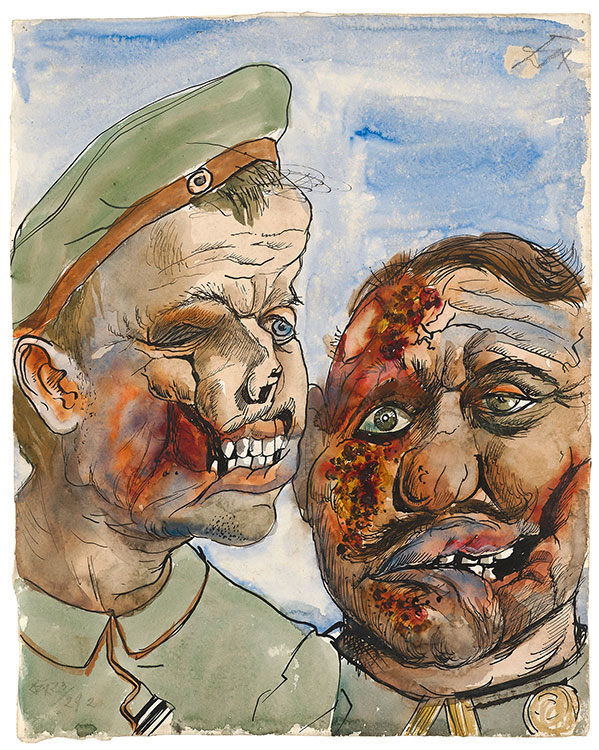
When World War I broke out in 1914, Dix voluntarily joined the German army as a machine gunner, fighting on both the eastern and western fronts. In works produced during the 1920s, the artist grappled with his wartime experiences and, in his own words, aimed to “depict the war objectively, without trying to arouse pity, without all the propaganda.” This sheet portrays two veterans in uniform with severe facial injuries inflicted by artillery shells. Rendered in watercolor washes that are almost disturbing in their vibrancy—from blue-purple bruises covering the soldiers’ faces to yellow and red scabs forming over their wounds—it emphasizes the immense human suffering resulting from military conflict.
Otto Dix
German, 1891–1969
In Memory of the Glorious Time, 1923
Watercolor and pen and ink
Kupferstich-Kabinett, Staatliche Kunstsammlungen Dresden, INV. NO. C 1969-83
© Kupferstich-Kabinett, Staatliche Kunstsammlungen Dresden. © Otto Dix / Artists Rights Society (ARS), New York
Photo: Herbert Boswank
Austeja Mackelaite, Annette and Oscar de la Renta Assistant Curator of Drawings and Prints
Images of war preoccupied Otto Dix during the late 1910s and early 1920s. The artist had first-hand experience of fighting, because he had served in the German army as a machine gunner during World War I. While in the trenches, he was making powerful cubo-futurist drawings, aesthetically exaggerating and even glorifying the experience of being in the battlefield. In the later years, however, he came to see his military experience differently, emphasizing not the heroic struggle but the inhumane consequences of war.
This sheet portrays two veterans in uniform. The man at left wears the black and white ribbon of the Iron Cross Second Class—a military decoration that Dix had also received for his services during the war. Both men have brutal facial injuries inflicted by artillery shells. Their faces are covered with fresh bruises and bloody, festering wounds. The artist’s thick application of watercolor makes looking at the drawing into an almost tactile experience, as if the wounds have materialized on the sheet itself.
This was a personal work for Dix. He made the drawing in 1923 and inscribed “Not for sale” on the back of the sheet. Indeed, the drawing never entered the art market. It stayed with Dix for forty years, until 1969, and then entered the collection of the Kupferstich-Kabinett, as a gift from the artist.
